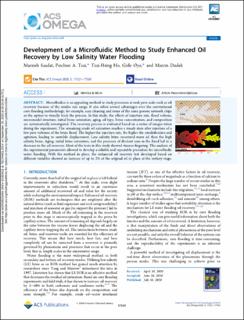| dc.contributor.author | Saadat, Marzieh | |
| dc.contributor.author | Tsai, Peichun Amy | |
| dc.contributor.author | Ho, Tsai-Hsing | |
| dc.contributor.author | Øye, Gisle | |
| dc.contributor.author | Dudek, Marcin | |
| dc.date.accessioned | 2020-09-29T09:20:36Z | |
| dc.date.available | 2020-09-29T09:20:36Z | |
| dc.date.created | 2020-09-15T15:19:30Z | |
| dc.date.issued | 2020 | |
| dc.identifier.citation | ACS Omega. 2020, 5 17521-17530. | en_US |
| dc.identifier.issn | 2470-1343 | |
| dc.identifier.uri | https://hdl.handle.net/11250/2680209 | |
| dc.description.abstract | Microfluidics is an appealing method to study processes at rock pore scale such as oil recovery due to the similar size range. It also offers several advantages over the conventional core flooding methodology, for example, easy cleaning and re-use of the same porous network chips or the option to visually track the process. In this study, the effect of injection rate, flood volume, micromodel structure, initial brine saturation, aging, oil type, brine concentration, and composition are systematically investigated. The recovery process is evaluated based on a series of images taken during the experiment. The remaining crude oil saturation reaches a steady state after injection of a few pore-volumes of the brine flood. The higher the injection rate, the higher the emulsification and agitation, leading to unstable displacement. Low salinity brine recovered more of the oil than the high salinity brine. Aging, initial brine saturation, and presence of divalent ions in the flood showed to decrease the oil recovery. Most of the tests in this study showed viscous fingering. The analysis of the experimental parameters allowed to develop a reliable and repeatable procedure for microfluidic water flooding. With the method in place, the enhanced oil recovery test developed based on different variables showed an increase of up to 2% of the original oil in place at the tertiary stage. | en_US |
| dc.language.iso | eng | en_US |
| dc.publisher | American Chemical Society | en_US |
| dc.rights | Navngivelse 4.0 Internasjonal | * |
| dc.rights.uri | http://creativecommons.org/licenses/by/4.0/deed.no | * |
| dc.title | Development of a microfluidic method to study enhanced oil recovery by low salinity water flooding | en_US |
| dc.type | Journal article | en_US |
| dc.type | Peer reviewed | en_US |
| dc.description.version | publishedVersion | en_US |
| dc.source.pagenumber | 17521-17530 | en_US |
| dc.source.volume | 5 | en_US |
| dc.source.journal | ACS Omega | en_US |
| dc.identifier.doi | 10.1021/acsomega.0c02005 | |
| dc.identifier.cristin | 1830143 | |
| dc.relation.project | VISTA: 6365 | en_US |
| dc.description.localcode | This is an open access article published under a Creative Commons Attribution (CC-BY) License, which permits unrestricted use, distribution and reproduction in any medium, provided the author and source are cited. | en_US |
| cristin.ispublished | true | |
| cristin.fulltext | postprint | |
| cristin.qualitycode | 1 | |

